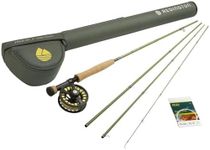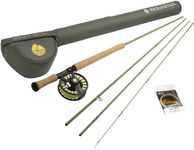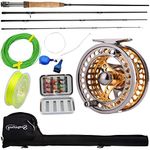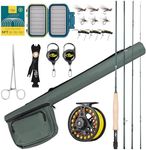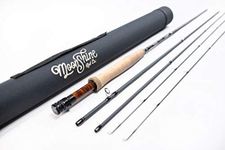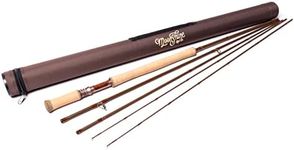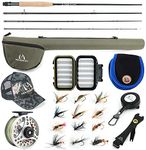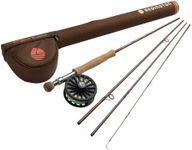Buying Guide for the Best Budget Fly Rods
Choosing the right fly rod can significantly enhance your fishing experience. The right rod will depend on the type of fishing you plan to do, the species you are targeting, and your personal preferences. Understanding the key specifications of fly rods will help you make an informed decision and ensure you get the best fit for your needs.Rod LengthRod length is the measurement from the butt of the rod to the tip. It is important because it affects casting distance, accuracy, and the ability to control the line. Fly rods typically range from 7 to 10 feet. Shorter rods (7-8 feet) are ideal for small streams and tight spaces, offering better control and precision. Medium-length rods (8-9 feet) are versatile and suitable for a variety of fishing conditions, making them a good choice for beginners. Longer rods (9-10 feet) provide greater casting distance and are useful in larger rivers or when fishing from a boat. Choose a rod length based on the type of water you will be fishing in and your casting style.
Rod WeightRod weight refers to the weight of the line that the rod is designed to cast, not the physical weight of the rod itself. It is crucial because it determines the size of the fish you can target and the type of flies you can cast. Fly rods are rated from 1 to 14 weight. Light rods (1-4 weight) are suitable for small fish like trout and panfish, and for delicate presentations. Medium rods (5-7 weight) are versatile and can handle a wide range of fish species, making them ideal for bass, larger trout, and light saltwater fishing. Heavy rods (8-14 weight) are designed for large fish like salmon, pike, and saltwater species. Select a rod weight based on the fish species you plan to target and the type of flies you will be using.
Rod ActionRod action describes how much and where the rod bends when pressure is applied. It is important because it affects casting distance, accuracy, and the ability to fight fish. Fly rods come in three main actions: slow, medium, and fast. Slow action rods bend throughout their entire length, providing a smooth and delicate presentation, ideal for small streams and light lines. Medium action rods bend in the upper half, offering a balance between casting distance and accuracy, making them versatile for various fishing conditions. Fast action rods bend mostly at the tip, providing greater casting distance and power, suitable for windy conditions and larger flies. Choose a rod action based on your casting style and the fishing conditions you expect to encounter.
MaterialFly rods are typically made from graphite, fiberglass, or bamboo. The material affects the rod's weight, flexibility, and durability. Graphite rods are lightweight, strong, and offer a fast action, making them popular for a wide range of fishing situations. Fiberglass rods are more flexible and durable, providing a slower action, which is ideal for small streams and delicate presentations. Bamboo rods are traditional and offer a unique feel and aesthetic, but they are heavier and require more maintenance. Choose a material based on your preference for weight, action, and the type of fishing you plan to do.
PiecesFly rods come in different numbers of pieces, typically ranging from two to six. The number of pieces affects the rod's portability and ease of transport. Two-piece rods are simple and offer a seamless feel, but they can be cumbersome to transport. Four-piece rods are the most popular, providing a good balance between performance and portability, making them easy to pack for travel. Multi-piece rods (five or more pieces) are highly portable and convenient for backpacking or air travel, but they may have slightly reduced performance due to additional ferrules. Choose the number of pieces based on how you plan to transport and store your rod.

